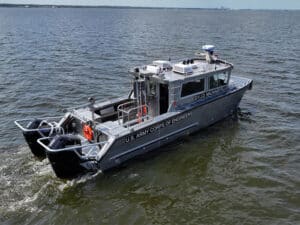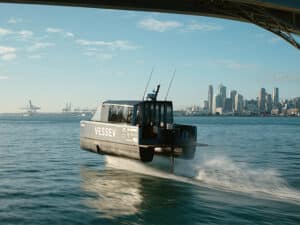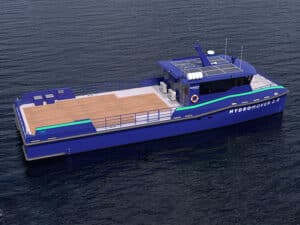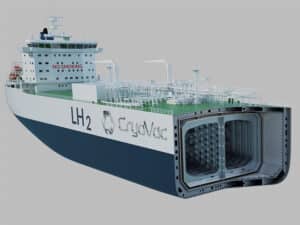
Junk rating for debt of Northrop Grumman shipbuilding spin-off
Written by Northrop Grumman is moving ahead with plans to spin off its shipbuilding activities as Huntington Ingalls Industries Inc.The new enterprise will enter operations carrying a considerable burden of debt.That led the three major credit rating agencies to last week rate Huntington Ingalls’ corporate credit rating as “non-investment grade,” a classification known as “junk.”
Northrop Grumman is moving ahead with plans to spin off its shipbuilding activities as Huntington Ingalls Industries Inc.The new enterprise will enter operations carrying a considerable burden of debt.That led the three major credit rating agencies to last week rate Huntington Ingalls’ corporate credit rating as “non-investment grade,” a classification known as “junk.”
Standard & Poor’s Ratings Services gave the company a BB-minus corporate credit rating. Fitch Ratings assigned a BB ratings and Moody’s Investors Service, assigned a Ba2. The highest grade is AAA.
Standard & Poor’s Ratings Services said last week that it had assigned its ‘BB-‘ corporate credit rating to Huntington Ingalls Industries Inc. but had assigned its ‘BB+’ issue-level rating to the company’s proposed $1.25 billion secured credit facility (which consists of a $600 million term loan and a $650 million revolver, both due in 2016) with a recovery rating of ‘1’, indicating expectations of very high (90%-100%) recovery in a payment default scenario. The agency also assigned its ‘B+’ issue rating to the company’s proposed $575 million unsecured notes due 2018 and $600 million unsecured notes due 2021 with a recovery rating of ‘5,’ indicating expectations of a modest (10%-30%) recovery. Standard & Poor’s says the outlook is stable.
“The ratings on Huntington Ingalls reflect the high leverage which will follow the planned spin-off from Northrop Grumman Corp., as well as its weak profitability, limited product and customer diversity, and the possible long-term budget pressures facing military shipbuilders,” said Standard & Poor’s credit analyst Christopher DeNicolo. “These factors are offset by the company’s position as one of only two builders of large ships for the U.S. Navy, steady intermediate-term demand supported by a large backlog, and its adequate liquidity. We assess Huntington Ingalls’ business risk profile as fair and its financial risk profile as aggressive.”
Standard &Poor’s noted that Northrop Grumman plans to spin off Huntington Ingalls to its shareholders once certain regulatory approvals are received, likely in the next few months. As part of the transaction, Huntington Ingalls will issue around $1.8 billion of new bank debt and public notes to finance a $1.5 billion payment to Northrop Grumman (in part to repay intercompany borrowings), with the remaining proceeds retained to provide liquidity. After a short transition period following the spin-off related to certain back-office functions, Northrop Grumman will have no connection to the company except for the guarantee of a small industrial revenue bond. We expect leverage to be high pro forma for the transaction, with total adjusted debt to EBITDA about 5x. However, the company has material post-retirement and self-insurance liabilities that are included in adjusted debt, which are largely recoverable under government contracts over time. If adjusted for expected recoverability, debt to EBITDA is likely to be below 4x.
“We believe credit protection measures (similarly adjusted) should be appropriate for the rating, with funds from operations (FFO) to debt of 20%-25% and EBITDA interest coverage 4.5x-5.0x, with gradual improvement possible as profitability improves and the company uses excess cash flows to reduce debt,” said the agency.
The outlook is stable. We believe the company’s relatively stable near-term revenues, supported by a large backlog, improving profitability, and debt reduction from excess cash flows, should result in steadily improving credit protection measures.
“We could raise the rating if these trends result in debt to EBITDA below 3.5x and FFO to debt above 25% (both ratios adjusted for recoverability of pension and self-insurance costs under government contracts),” Mr. DeNicolo continued. “Although less likely, we could lower the ratings if profitability does not improve as we expect or if reduced funding for military shipbuilding results in debt to EBITDA above 4.5x and FFO to debt below 15% on a sustained basis.”
Fitch Ratings said it expects to assign a ‘BB’ Issuer Default Rating (IDR) to Huntington Ingalls Industries, Inc. (HII) upon the completion of the company’s potential spin-off from Northrop Grumman Corporation (NOC). Fitch also expects to rate HII’s proposed five-year senior secured $600 million term loan facility, five-year $650 million revolving credit facility, and approximately $1.18 billion of Rule 144A senior unsecured notes. Proceeds from the term loan and the notes will be used to pay a transfer to NOC, repay intercompany debt owed to NOC, and fund HII’s initial liquidity. Fitch expects the debt transactions and spin-off will be completed in the first quarter of 2011.
Fitch expects to rate HII as follows:
- Long-term IDR at ‘BB’;
- Senior secured term loan at ‘BBB-‘;
- Senior secured revolving credit facility at ‘BBB-‘;
- Senior unsecured notes at ‘BB’.
The Rating Outlook is expected to be Stable. Fitch expects HII will have approximately $1.9 billion of outstanding debt after the potential spin-off including the debt mentioned above and approximately $105 million of senior unsecured legacy debt.
Fitch says its ratings reflect HII’s position as a leading company in the defense shipbuilding industry with core capabilities in building aircraft carriers, nuclear submarines, large amphibious attack vessels, and surface combatants. The company is the sole source manufacturer on about 66% of its revenues, including building and overhauling aircraft carriers for the U.S. Navy, and it has a large and highly visible backlog ($17 billion funded and unfunded as of Sept. 30, 2010). HII is well-positioned in the current defense spending environment, with roles on four of the U.S. Dept. of Defense’s (DOD) top 12 programs in the fiscal 2011 budget. HII also has a high percentage of cost-plus and fixed-price incentive contracts, which have less risky terms than firm fixed-price contracts, although margins are generally lower. Fitch expects the company will follow a conservative financial strategy after the says Fitch, HII’s pension funding position (91% at the end of 2009) is “relatively healthy compared to many other large defense contractors.”
Fitch’s key concerns include HII’s revenue concentration with the U.S. Navy and Coast Guard, the ongoing restructuring at the company’s Gulf Coast operations, and uncertainty about U.S. defense spending after fiscal 2012. HII generates nearly all of its revenues from the U.S. government, exposing the company to changes in U.S. Navy and U.S. Coast Guard plans regarding future fleet needs. HII will be undergoing an extensive reorganization at least through 2012 to address performance issues at its Gulf Coast operations; this restructuring includes the closing of its Avondale shipyard. Additional rating concerns include the company’s relatively low margins, weak free cash flow in the past two years, program execution risks, the percentage of the workforce that is unionized, exposure to hurricanes, and the lack of a track record as a standalone company. HII will need to develop in-house support functions which are currently handled by NOC, including some information technology.
Fitch’s expectation to notch up the senior secured credit facility by two rating notches from the IDR to ‘BBB-‘ is based on the coverage provided by HII’s tangible assets and operating EBITDA compared to the fully drawn facility. The collateral for the facility includes substantially all of HII’s assets with the exception of the Avondale shipyard and a few other exclusions. In assigning the rating, Fitch noted Newport News’ solid backlog and strategic importance to the U.S. Navy. The amount of secured debt compared to the amount of unsecured debt and equity in HII’s expected capital structure also supported Fitch’s notching analysis.
Fitch says HII is expected to have approximately $600 million of liquidity consisting of $200 million-$300 million of cash with the remainder provided by the $650 million revolving facility, with up to $350 million usable for letters of credit (LCs). The actual liquidity level may exceed the targeted $600 million if HII does not utilize the full Letter of Credit (LC) allowance under the revolving facility, but Fitch’s forecasts include the assumption that a substantial portion of the LC facility will be used to cover workers’ compensation. Debt maturities will be minimal for the next several years other than amortization of the term loan. Required pension contributions should also be manageable given HII’s funding position (91.1% at the end of 2009). After the spin-off and debt issuances Fitch expects HII will have leverage (gross debt to EBITDA) of approximately 3.2 times (x)-3.4x, with the potential for steady improvement over the next several years with some debt reduction and restructuring-driven margin expansion.
Lower discretionary pension contributions, a smaller increase in working capital and lower capital expenditures eased the pressure on HII’s free cash flow (FCF; cash from operations less capital expenditures and dividends) in 2010. HII’s FCF in 2009 was negative $269 million, and Fitch expects FCF to be weak in 2010 and 2011, although improved from 2009. Through the nine months ended Sept. 30, 2010 HII’s FCF was $55 million, compared to negative $329 million for the same period in 2009. Fitch expects that FCF could improve materially in 2012 and 2013 as restructuring abates and some capital spending projects are completed. Fitch’s projections include no share repurchases or dividends, although HII’s dividend policy will be established by the board of directors based on HII’s financial conditions and other factors. Fitch’s financial projections show that HII should be able to build cash based on the assumptions of a successful Gulf Coast restructuring and continued support of the company’s programs in the defense budget.
Defense spending is a key driver of HII’s financial performance and credit quality. HII generated approximately 99% of its estimated 2010 revenues from the U.S. government (including Foreign Military Sales), primarily the U.S. DOD. Fitch believes the outlook for HII’s operations is still favorable through fiscal 2012. Beyond fiscal 2012 there is more uncertainty for core spending levels, due to federal budget pressures. Fitch believes that HII has credit metrics strong enough to withstand lower defense spending levels while retaining the current ratings.
Moody’s Investors Service said it has assigned new debt ratings to Huntington Ingalls Industries, Inc. (“Huntington Ingalls”) including: Ba2 corporate family and probability of default ratings, Baa3 senior secured bank credit facility rating, Ba3 senior unsecured bond rating, and a speculative grade liquidity rating of SGL-2. The rating outlook is stable.
Moody’s said the Ba2 CFR reflects Huntington Ingalls’ established position as a critical shipbuilding contractor to the U.S. Navy, with stable revenues although a moderate return on assets of about 2% to 3% (net income to average assets, Moody’s adjusted).
“We expect 2011 debt to EBITDA of about 4.0 times, which would be consistent with the Ba2 rating level,” said the agency. “We also anticipate operating margins should gradually improve over time which should produce declining financial leverage.”
Moody’s says it anticipates the Navy continuing to award contracts at a pace that basically maintains the company’s current backlog level, which provides good visibility of forward revenues. Assuming costs in line with recent levels (excluding charges), the rating envisions EBIT margin improving to the mid-single digit percentage range. This gradually improving EBIT margin should lower leverage over time. Longer term, says Moody’s, U.S. fiscal deficits could pressure shipbuilding outlays but we do not see that as a risk to intermediate-term revenues.
“We do not anticipate Gulf Coast segment margins will approach those of the Newport News segment for some time, even with the planned closure of the Avondale, Louisiana shipyard,” says Moody’s. “Although charges related to the Avondale closure and problems on amphibious ship contracts have likely concluded, the rating acknowledges that completing vessels LPD 23 and LPD 25—as Avondale closes—could prove a challenge. Operational improvements made in recent periods should permit better performance on future surface combatant ship contracts, especially the DDG-51 program re-start. Huntington Ingalls appears reasonably positioned to receive a meaningful portion of the U.S. Navy’s DDG-51 ship construction contracts, which would be handled by the Gulf Coast segment.”
Moody’s says the speculative grade liquidity rating of SGL-2 reflects a good liquidity profile, which adds support to the Ba2 CFR. “A beginning cash balance of about $300 million and no beginning borrowing expected on the $650 million five-year revolver, provide a comfortable level of available liquidity,” says the agency. “Near-term maturities will be limited and we expect the company should be cash flow generative over 2011. The SGL-2 anticipates adequate headroom under the first lien credit facility’s financial ratio covenant tests.”
Moody’s says that upward rating momentum would develop with backlog continuing at current levels and steadily improving Gulf Coast operations, leading to an expectation of EBIT margin in the upper single digit percentage range (8% to 9%). At this margin level, assuming a balanced financial policy, leverage metrics would likely improve to include debt to EBITDA of 3.0 times and free cash flow to debt above 10%. Expectation of a good liquidity profile would as well accompany an upgrade.
Downward rating momentum would develop if backlog were to materially weaken or if Moody’s were to expect return on assets sustained below 1%. Debt to EBITDA exceeding 5.0 times, or a weakening liquidity profile could also cause a ratings downgrade.
Ratings assigned, subject to review of final documentation:
- $650 million senior secured revolving credit due 2016, Baa3 LGD2, 21%
- $600 million senior secured term loan B due 2016, Baa3 LGD2, 21%
- $575 million senior unsecured notes due 2018, Ba3 LGD5, 74%
- $600 million senior unsecured notes due 2021, Ba3 LGD5, 74%
- Speculative grade liquidity, SGL-2
When Huntington Ingalls’ separation from Northrop Grumman Corporation occurs, the remaining $22 million of 4.55% Gulf Opportunity Zone Industrial Revenue Bonds due 2028 (“GoZone Bonds”) (Baa1) will become an obligation of Huntington Ingalls’ main operating company. At that time, the GoZone Bonds will no longer benefit from the credit support of Northrop Grumman Corporation (Baa1). Moody’s therefore expects to lower the rating of the GoZone Bonds to Ba3 LGD5, 74% from Baa1 following the spin-off.





Leave a Reply
You must be logged in to post a comment.